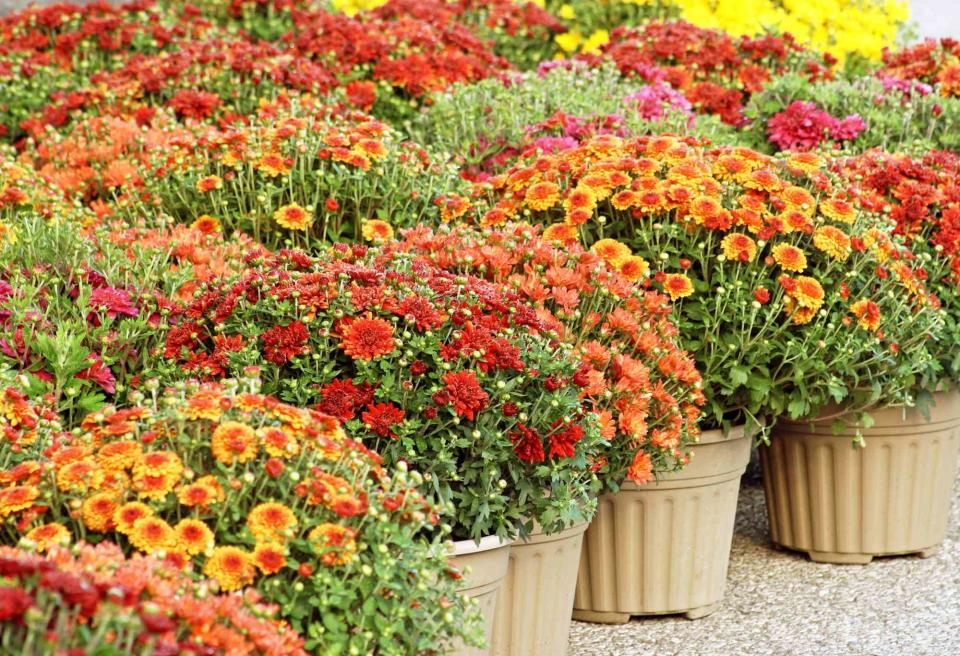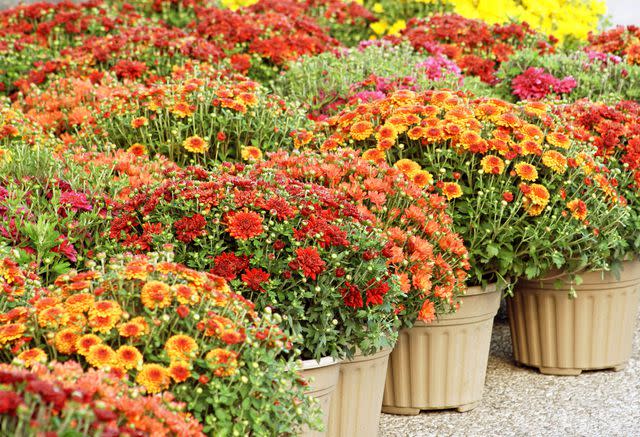How To Grow And Care For Mums (Chrysanthemums)
Keep your yard dazzling with vivid reds, golds, and yellows with the addition of mums.

Fact checked by Elizabeth Berry
The daytime temperatures may still be soaring upwards as the end of summer approaches, but believe it or not, containers of colorful chrysanthemums—or mums as we like to call them—will soon be appearing at your local plant nurseries and gardening centers. Perhaps no other fall flower creates as much excitement as the mum.
These happy blooms are best planted in the spring once the ground is free of frost. This gives them time over the hotter months to establish roots before they become showstoppers in the fall. If you plant garden mums in the fall in colder climates, odds are they will not survive the winter.
The autumn arrival of these brightly colored blossoms signal the coming of shorter days, cooler weather, outdoor decorating, cozy sweaters, pumpkins, apples, and so many more wonderful things. If you are looking to make Thanksgiving even more special, a centerpiece featuring mums will set the celebratory tone. Follow these easy steps to get the best out of your mums this fall.
Please bear in mind that the Chrysanthemum is toxic to dogs, cats and horses. As long as your fur family does not have access to the plant, feel free to enjoy the fun explosions of color that come with a garden featuring mums.
Common name | Garden mums, garden chrysanthemums, mums |
Botanical name | Chrysanthemum spp. |
Family | Asteraceae |
Plant type | Perennial |
Mature size | 1-3 ft. tall, 1-2 ft. wide |
Sun exposure | Full |
Soil type | Moist but Well-drained |
Soil pH | Neutral to acidic (5.8 to 6.8) |
Bloom time | Fall |
Flower color | Orange, bronze, red, purple, lavender, pink, green, white, and yellow |
Hardiness zone | 5-9 (USDA) |
Native area | Asia and northeastern Europe |

Chrysanthemum Care
To maximize the chrysanthemum's bloom time, buy the plants just as they are starting to break bud. This strategy means buying mums with the least number of buds showing color since you will see a better bloom from this planter later. You'll want to ensure enough buds are showing to check the color of the plant you're buying. Not only will you be sure of what color mums you'll end up with when they fully bloom, but the flowers will also last longer this way. Once the buds open up more, you are practically guaranteed flowers.
Mums are ideal for container planting because of their shallow root systems. Although considered a perennial, you can use those pots of blooming mums sold in the fall as annuals to replace summer annuals that are past their prime. Tuck the mums in beds, borders or planters to keep the color coming until frost.
How To Plant Mums
Mums purchased from large garden centers are likely to be root bound and starving for soil, water, and nutrients. You'll need to repot them and give them plenty of room to breathe. Pick a container or garden spot that offers the mums ample space for the root ball to spread out and grow.
After a few touches of frost, the foliage on your mums will begin to brown. That means it is time to replant potted mums in your garden. Also, if you had put mums into beds for temporary fall color, you may want to transplant them to another location, as well.
Light
Whether you place your mums in pots to decorate your porch or use them as a bedding plant, you want to choose a spot that gets a minimum of six hours of direct sunlight daily—even more for bigger plants.
Water
Water mums well and continue to water every other day as long as the plant continues blooming. Keep mums in moist soil, but not wet.
Soil
When repotting or relocating your mums, choose a location with well-draining soil. It would help if you also took time to remove spent and faded blooms to encourage even more buds to open, and you will have beautiful, colorful mums throughout the season.
Temperature And Humidity
Chrysanthemums are tolerant to the USDA hardiness zones to 5 to 9, with some varieties able to tolerate lower temperatures. If you are growing this flowering plant indoors, the minimum temperature is 20°F. The most extreme heat tolerated is 90°F to 95°F.
The optimal temperature for chrysanthemums, whether being raised indoors or in a garden bed, is between 62 and 72 degrees Fahrenheit. Mums thrive in humid conditions, which should be between 70% and 90%. This makes the South prime territory for this gorgeous plant. The humidity level will affect their mass and growth.
Fertilizing And Pruning
Once in the ground, cut the stems of the mums at three to four inches above the ground. Leaving a little bit of the stems will ensure you have a full plant next year, as the new stems will grow from these trimmed stems. Once the ground has frozen, add a layer of either mulch, straw, or leaves over the plant to help keep it insulated.
Mulching keeps the soil from going through a cycle of warming to freezing and back to warming, which only confuses the plant as to whether it should stay dormant or begin new growth. Watch for new foliage in the spring, fertilize with organic fertilizer, and pinch every two to four weeks to ensure you have sturdy plants come fall.
Types Of Mums
While the Chrysanthemum genus includes about 40 species, there are countless horticultural varieties and cultivars of mums available. Mums are a part of the daisy family, which includes 1,620 genera and 23,600 species of herbs, shrubs, and trees distributed throughout the world, Asteraceae is one of the largest plant families.
Propagating Mums
If propagating from a cutting, you should cut your mum stems 4 inches tall at a 45-degree angle, plucking leaves off an inch from the bottom. Dip your cuttings in a root hormone and plant in a perlite and compost mixture. It will take a couple of weeks for roots to grow, and then you can transplant them into larger pots or into your garden.
Dividing mum plants is one of the best ways to propagate them. You remove the mum from the container or dig it up and cut the plant and roots into sections with a sharp knife. Make sure each section has roots and replant them into containers or in your garden.
How To Grow Mums From Seed
Growing mums from seeds requires trays of good quality and well-drained, fine potting mix. Get started about six to ten weeks before the last frost is expected. This usually lands in a timeframe between February and March. Keep the soil humid but not wet and at about 70 to 75 degrees F to see the seedlings appear in 10 to 21 days.
Overwintering
Often, it isn't necessarily the cold weather that kills mums, but the ice that forms around the roots if the mums are sitting in water. Soil that drains properly is key to successfully overwintering mums. You may also want to choose a somewhat sheltered location from strong, cold winter winds, which can also be harsh on mums.
Common Problems With Mums
The challenges that present with mums largely have to do with water and light issues. Lanky and floppy stems might present, for instance, and the cause of this is too much shade. Cut them back and move your chrysanthemum to a brighter spot.
Stems can sometimes become too woody, and this is due to poor watering. On the other hand, the discoloring of leaves could be a result of too much watering. Lack of nutrients, poor fertilization and a fungal infection can also cause this symptom.
Frequently Asked Questions
How long can mums live?
With ample time to grow their roots, garden mums can live for three to four years in USDA Zones 5 to 9.
What plants are similar to mums?
If you'd like to try give another fall flowering plant a go, check out asters, a fresh alternative to mums.
Where should I place mums if growing them indoors?
Mums need six hours of sunlight a day, but too much sun will shorten their blooming cycle. Put your indoor plants in a place where they will experience partial shade. Protecting potted mums from heat stress will keep them blooming longer.
For more Southern Living news, make sure to sign up for our newsletter!
Read the original article on Southern Living.

